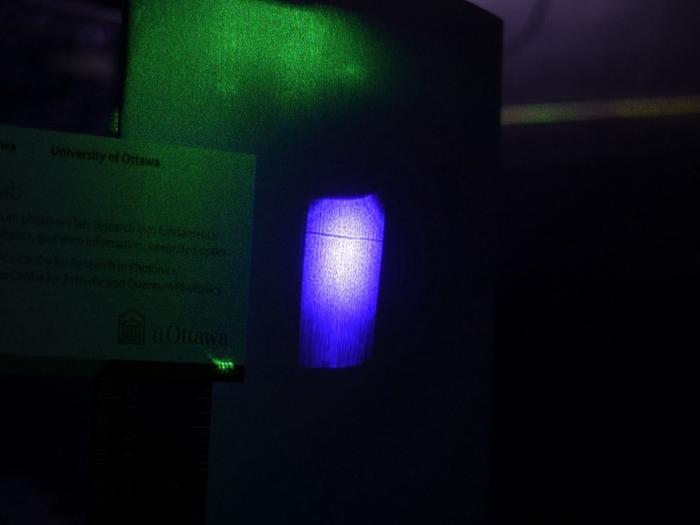In a discovery that challenges basic physics principles, researchers have shown that under specific conditions, a laser beam can block light and cast a visible shadow. The finding, made using a ruby crystal and precisely configured lasers, demonstrates an effect previously thought impossible since light typically passes through other light without interacting.
Journal: Optica, November 14, 2024, DOI: 10.1364/OPTICA.534596 | Reading time: 4 minutes
A Shadow from Light
“Laser light casting a shadow was previously thought impossible since light usually passes through other light without interacting,” explains research team leader Raphael A. Abrahao. The team used a ruby crystal cube illuminated by blue light from the side while a green laser passed through it.
The interaction created a shadow on a screen visible as a dark area where the green laser blocked the blue light. The shadow showed all the characteristics of a normal shadow – visible to the naked eye, following surface contours, and moving with its source.
Making the Impossible Possible
The effect occurs because the green laser changes how the ruby crystal absorbs blue light. When the green laser passes through the crystal, it creates a region that absorbs more blue light, resulting in a visible shadow with approximately 22% contrast – similar to a tree’s shadow on a sunny day.
The discovery began with an unusual observation. Scientists noticed that 3D visualization software depicted laser beams casting shadows, which they knew shouldn’t happen. This sparked a discussion that led to designing an experiment to see if they could create this effect in reality.
Future Applications
“This new finding could prove useful in various applications such as optical switching, devices in which light controls the presence of another light, or technologies that require precise control of light transmission, like high-power lasers,” notes Abrahao. The team plans to investigate other materials and wavelengths that might produce similar effects.
Glossary
- Ruby crystal: A crystal made of aluminum oxide with chromium impurities that give it unique optical properties
- Optical switching: Technology where one light beam controls another
- Wavelength: The distance between peaks in a light wave that determines its color
- Nonlinear absorption: When a material’s light absorption changes based on light intensity
Test Your Knowledge
1. What contrast level did the laser shadow achieve?
The shadow showed approximately 22% contrast, similar to a tree’s shadow on a sunny day.
2. What colors of laser were used in the experiment?
A green laser beam passed through the ruby crystal while blue light illuminated it from the side.
3. What inspired scientists to attempt this experiment?
They noticed 3D visualization software depicted laser beams casting shadows, which sparked a discussion about whether it could be done in reality.
4. What makes this shadow behave like a normal shadow?
It is visible to the naked eye, follows surface contours, and moves with its source – just like shadows cast by solid objects.
Enjoy this story? Subscribe to our newsletter at scienceblog.substack.com
If our reporting has informed or inspired you, please consider making a donation. Every contribution, no matter the size, empowers us to continue delivering accurate, engaging, and trustworthy science and medical news. Independent journalism requires time, effort, and resources—your support ensures we can keep uncovering the stories that matter most to you.
Join us in making knowledge accessible and impactful. Thank you for standing with us!

